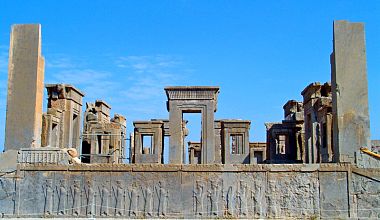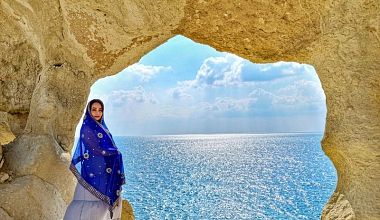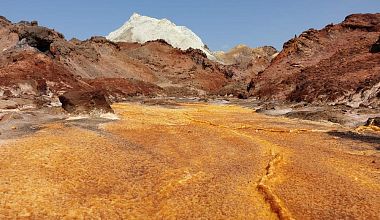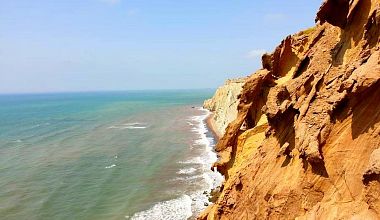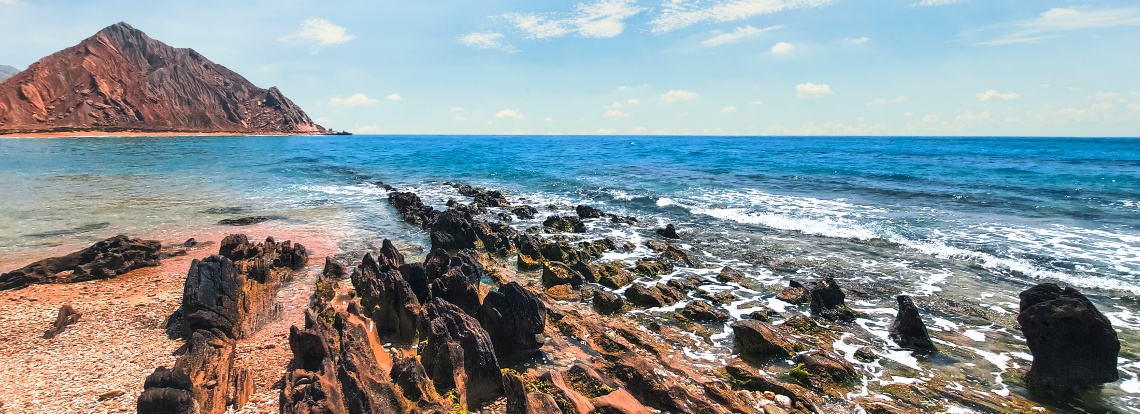
Reasons to go on a group tour in Iran
- to visit cultural heritage and natural sites included on the UNESCO World Heritage list;
- to explore the remains of great empires and civilisations, and to discover artefacts from the periods of their rise and fall;
- to observe the transformation of the art of a conquered people, as new and previously unknown motifs and methods of art are infused and integrated;
- to visit fortresses built by the Portuguese, and learn about the colonial wars of the European powers in their attempt to gain control of the Persian Gulf trade routes;
- to find out how and why events of the past centuries still resonant in the current news of the international media;
- to gain an insight into the everyday life of Iran, one of the world's most mysterious countries.
On the group tour to Iranwe will
- walk the path of kings and conquerors through the ruins of the once great Persepolis, as destroyed by Alexander the Great;
- compare the grandeur and diversity of the architecture of Cyrus the Great, Avicenna, Hafiz and Imam Khomeini;
- find out which elements of European architecture, adopted during the reign of the Qajar dynasty, harmoniously fit into the interiors of mosques and houses of the Iranian nobility;
- tour the Martian landscapes of Hormuz Island via Tuk Tuk;
- charter a boat tour to explore waterways surrounded by mangrove forests;
- feed the dolphins (don't forget to bring some fish);
- relax on the secluded beaches of Hengam Island;
Arrival in Tehran. Sightseeing tour. Departure to Kashan.
You will be greeted by your guide at the airport, marking the start of your travel through Iran. Your journey will begin with a visit to the Mausoleum of Ruhollah Khomeini.
The complex, the first site located on route from Imam Khomeini International Airport to Tehran, is known for its impressive size. More importantly though, it is of great cultural significance. The tomb of the father of the Islamic Revolution is a key point in understanding modern Iranian history and the role of the revolution in the destinies of three generations of the Iranian people.
Following this is an excursion to Golestan Palace, also known as the "Marble Palace", which exhibits the grandeur of the architecture of the Qajar Dynasty of the 16th century.
Visiting the sights of the city. Viewing the production of rose water. Departure to Matinabad. A night in the desert.
Kashan has been a key stop along passing trade routes since ancient times. The caravans, tired of their long journeys, would often first go to the Persian baths, which were not only places to relax, but also meeting places where deals were discussed and negotiations were conducted. One such place was the historical site of the Sultan Amir Ahmad Bathhouse. The hammam building is decorated with mosaics and frescoes worthy of a royal palace. Like some of the affluent travellers of the past, this is also where you will start to explore the city of Kashan.
In the evening you will depart for Matinabad Desert Camp, an eco-friendly camp located within the sand dunes.
The oldest settlement in Iran, which has existed for over 2000 years.
In the morning you will travel to the village of Abyaneh, famous for its unique architecture of houses built of red clay. The customs and culture of Abyaneh are notably different from those found in the central part of Iran.
The locals continue the tradition of hand weaving and women still wear traditional folk costumes. You'll find a variety of souvenir handicrafts for sale produced here. You can explore the ruins of a medieval military stronghold, as well as a mosque.
After a stroll through the streets of Abyaneh village, you will continue your tour to the cultural capital of Iran.
Sightseeing tour of Isfahan city. Exploring the city's highlights.
Your exploration of the city will begin with a visit to the main attraction of Isfahan — Naqsh-e Jahan Square.
Constructed in the early 17th century, this square is a remarkable urban architectural ensemble that combines the Shah Mosque, Sheikh Lotfollah Mosque, Aali Qapu Palace and various shopping malls. All the architectural monuments facing the square are included on the UNESCO World Heritage List. The Shah Mosque, also known as the Emam Khomeini Mosque (renamed after the Islamic revolution), was built in the 17th century by order of Shah Abbas I and is a noteworthy attraction.
Aali Qapu Palace, the residence of Shah Abbas, is situated not far from the Shah Mosque. After a walk through Naqsh-e Jahan Square you will visit the Sheikh Lotfollah Mosque and Vank Cathedral.
In the evening you will go for a walk to the Si-o-Se Pol Bridge.
Journey to the city of Isfahan. Exploring the cities of Nain and Meybod.
Your adventure begins in the morning with a trip to Yazd - also known as the city of the Zoroastrians. On the way you will visit the city of Nain, the Narin Castle, the pigeon tower.
Later in the afternoon you will have an opportunity to explore Yazd.
Older than the Egyptian pyramids and the same age as the biblical Babylon, Yazd is one of the oldest cities in the world. A status that has allowed it to preserve its unique traditional architecture to the present day.
You will visit various sites of note within the city centre, as well as the Zoroastrian Fire Temple of Yazd, and the Towers of Silence.
The ancient capitals of the Persian Empire.
You will journey from Yazd to Shiraz early in the morning, with stops at the ancient cities of Pasargadae, Naqsh-e Rostam and Persepolis along the way. The first stop will be in the city of Pasargadae, which is an outstanding expression of Achaemenid royal architecture.
It was here that Cyrus the Great initially built the capital of the Persian Empire, utilising the participation of the various peoples of the lands he conquered. Spanning from the eastern Mediterranean and Egypt to the Indus River in India, the vast Achaemenid Empire is considered the first empire characterised by respect for the cultural diversity of its peoples. This respect was reflected in the Achaemenid architecture, which became a generalised representation of the various cultures of the empire.
A brief journey from Pasargadae you will find the tombs of the great generals of the Persian Empire - Darius I, Xeroxus I, Artaxerox I and Darius II. The ancient city of Persepolis is located in close proximity to Naqsh-e Rostam. This site features an ensemble of majestic entrances, monumental staircases, throne rooms (such as Apadana Palace), reception halls and outbuildings. It is one of the greatest archaeological sites in the world, of which there is no equal and it indicates the level of the advanced ancient civilization.
After visiting the ancient cities of Iran, you will take a trip to the city of Shiraz.
A photo shoot at Nasir al-Mulk Mosque and a flight to Qeshm Island.
In the heart of Iran, within the province of Fars, you will find the city of Shiraz, a place of blooming gardens, poetry and wine. The beauty of Shiraz was praised in the poetry of the great Persian lyricists, Hafiz and Saadi. Their tombs have become the cultural heritage of Shiraz attracting pilgrims from all over the world who travel there with the hope to touch the ancient shrines and explore the secrets of the Persian soul. As the locals say, “It's hard not to be a poet in Shiraz”.
At dawn you will visit Nasir al-Mulk Mosque for a photo shoot. It is better to visit the mosque early in the morning, when the first rays of sunlight pass through the colorful stained glass windows, filling the prayer hall with various shades of colours and patterns. These reflections play across the walls, arches and even visitors, creating a magical atmosphere.
After a tea break you will continue your tour through Shiraz. You will learn about Persian poetry, visit the sights of the city and find out about the teachings of Sufism and its followers.
You will be transported to Bandar Abbas, either by plane or, should flights be unavailable, by car. From there you will be ferried to Qeshm Island.
Beach holiday.
Departure to the port, boat tour to Hengam Island. A beach holiday on Hengam Island.
On Hengam there is only one small village, where you can explore the local market, which offers various handmade souvenirs, and get acquainted with the traditional culture and way of life of local residents. You will also visit the “Silver Beach”, which is famous for its black sand, whose colour is the result of numerous minerals within the sand.
Dolphins are often seen along the coast of Hengam. If you are lucky you may be able to see them up close. The island is also home to other exotic animals such as sea turtles, monitor lizards, roe deer.
There are secluded beaches almost all the way around the coastline of the island, which is also perfectly comfortable for entering into the sea or relaxing on the shore.
Trip to the Chahkooh Canyon, a chartered voyage through waterways surrounded by mangrove forests
The infrastructure of Qeshm Island is not as well maintained as the famous Kish Island, but nevertheless it remains equally as attractive.
The exotic nature of the island is recognised as a national geopark and is under UNESCO protection.
On this day you will be taken on an excursion to Chahkooh Canyon, a valley with unique formations shaped by soil erosion.
After lunch you will undertake a voyage by boat through waterways surrounded by mangrove forests, mostly consisting of Avicennia trees, which were named in honour of the great scientist Avicenna. During this time of the year, the forests teem with various animals including migratory birds, reptiles, and fish. You may be fortunate, you may see green herons, flamingos, pelicans and fishing eagles.
Tuk Tuk tour through Hormuz Island.
On the tenth day of the Iran tour you will travel to Hormuz Island, located at the mouth of the Strait of Hormuz. This small island with a centuries old history and fantastic unearthly landscapes has received the descriptuion Martian among tourists due to its unusual red sands.
The island is renowned for its vivid colours, with its soil boasting over 80 shades. This ranges from scarlet to marble, with red, due to its high ochre content, being the most dominant. In addition to its pristine nature coupled with picturesque landscapes, there is an ancient Portuguese fortress on the island, a remnant of its time under the Portuguese Empire centuries before.
After visiting Hormuz, you will return to Qeshm Island.
Beach holiday and return to Tehran.
The day will be spent relaxing on the shores of the Persian Gulf.
Departure to Tehran. Check in at a hotel near the airport.
Flight home.
- Tehran
- Isfahan
- Yazd
- Shiraz
- Qeshm Island
- Hormuz Island
- Hengam Island
- English speaking guide
- Entry tickets
- Transfer
- Accommodation in a 3-4 star hotel
- Domestic flights
- Guided Excursions
- Travel insurance
- Iranian visa
- International flights
- Lunches and dinners

